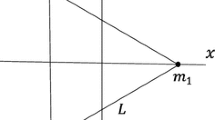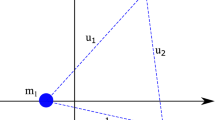Abstract
We consider a restricted four-body problem, with a precise hierarchy between the bodies: two larger bodies and a smaller one, all three of oblate shape, and a fourth, infinitesimal body, in the neighborhood of the smaller of the three bodies. The three heavy bodies are assumed to move in a plane under their mutual gravity, and the fourth body to move in the three-dimensional space under the gravitational influence of the three heavy bodies, but without affecting them. We first find that the triangular central configuration of the three heavy oblate bodies is a scalene triangle (rather than an equilateral triangle as in the point mass case). Then, assuming that these three bodies are in such a central configuration, we perform a Hill approximation of the equations of motion describing the dynamics of the infinitesimal body in a neighborhood of the smaller body. Through the use of Hill’s variables and a limiting procedure, this approximation amounts to sending the two larger bodies to infinity. Finally, for the Hill approximation, we find the equilibrium points for the motion of the infinitesimal body and determine their stability. As a motivating example, we identify the three heavy bodies with the Sun, Jupiter, and the Jupiter’s Trojan asteroid Hektor, which are assumed to move in a triangular central configuration. Then, we consider the dynamics of Hektor’s moonlet Skamandrios.




Similar content being viewed by others
References
Arredondo, J.A., Guo, J., Stoica, C., Tamayo, C.: On the restricted three body problem with oblate primaries. Astrophys. Space Sci. 341(2), 315–322 (2012)
Arredondo, J.A., Perez-Chavela, E.: Central configurations in the Schwarzschild three body problem. Qual. Theory Dyn. Syst. 12(1), 183–206 (2013)
Asique, M.C., Prasad, U., Hassan, M.R., Suraj, M.S.: On the photogravitational R4BP when the third primary is a triaxial rigid body. Astrophys. Space Sci. 361(12), 379 (2016)
Alvarez-Ramirez, M., Vidal, C.: Dynamical aspects of an equilateral restricted four-body problem. Math. Probl. Eng. 2009, 181360 (2009)
Burgos-García, J.: Families of periodic orbits in the planar Hill’s four-body problem. Astrophys. Space Sci. 361(11), 353 (2016)
Burgos-García, J., Delgado, J.: On the “blue sky catastrophe” termination in the restricted four-body problem. Celest. Mech. Dyn. Astron. 117(2), 113–136 (2013a)
Burgos-García, J., Delgado, J.: Periodic orbits in the restricted four-body problem with two equal masses. Astrophys. Space Sci. 345(2), 247–263 (2013b)
Burgos-García, J., Gidea, M.: Hill’s approximation in a restricted four-body problem. Celest. Mech. Dyn. Astron. 122(2), 117–141 (2015)
Boyce, W.: Comment on a formula for the gravitational harmonic coefficients of a triaxial ellipsoid. Celest. Mech. Dyn. Astron. 67, 107–110 (1997)
Baltagiannis, A.N., Papadakis, K.E.: Periodic solutions in the Sun–Jupiter–Trojan asteroid-Spacecraft system. Planet. Space Sci. 75, 148–157 (2013)
Bello, N., Singh, J.: On the stability of triangular points in the relativistic R3BP with oblate primaries and bigger radiating. Adv. Space Res. 57(2), 576–587 (2016)
Bello, N., Umar, A.: On the stability of triangular points in the relativistic R3BP when the bigger primary is oblate and the smaller one radiating with application on Cen X-4 binary system. Results Phys. 9, 1067–1076 (2018)
Celletti, A., Gales, C.: Dynamics of resonances and equilibria of Low Earth Objects. SIAM J. Appl. Dyn. Syst. 17(1), 203–235 (2018)
Corbera, M., Llibre, J., Pérez-Chavela, E.: Equilibrium points and central configurations for the Lennard-Jones 2- and 3-body problems. Celest. Mech. Dyn. Astron. 89(3), 235–266 (2004)
Descamps, P.: Dumb-bell-shaped equilibrium figures for fiducial contact-binary asteroids and EKBOs. Icarus 245, 64–79 (2015)
Dvorak, R., Lhotka, C., Zhou, L.: The orbit of 2010 TK7: possible regions of stability for other Earth Trojan asteroids. Astron. Astrophys. 541, A127 (2012)
Diacu, F., Stoica, C., Zhu, S.: Central configurations of the curved n-body problem. J. Nonlinear Sci. 28(5), 1999–2046 (2018)
Gabern, F., Jorba, A.: Restricted four and five body problems in the solar system. In: Libration Point Orbits and Applications, pp. 573–586. World Scientific (2003)
Gidea, M., Niculescu, C.P.: A Brief Account on Lagrange’s Algebraic Identity. Math. Intell. 34(3), 55–61 (2012)
Hill, G.W.: Researches in the lunar theory. Am. J. Math. 1(1), 5–26 (1878)
Howell, K.C., Spencer, D.B.: Periodic orbits in the restricted four-body problem. Acta Astronaut. 13(8), 473–479 (1986)
JPL Solar System Dynamics: https://ssd.jpl.nasa.gov/ (2018). Accessed 1 August 2018
Kuhn, J.R., Bush, R., Emilio, M., Scholl, I.F.: The precise solar shape and its variability. Science 337(6102), 1638–1640 (2012)
Kepley, S., Mireles James, J.D.: Chaotic motions in the restricted four body problem via Devaney’s saddle-focus homoclinic tangle theorem. J. Differ. Eqn. 266(4), 1709–1755 (2019)
Lhotka, C., Celletti, A.: The effect of Poynting-Robertson drag on the triangular Lagrangian points. Icarus 250, 249–261 (2015)
McCuskey, S.W.: Introduction to Celestial Mechanics. Addison-Wesley Series in Aerospace Science. Addison-Wesley, Boston (1963)
Marchis, F., Durech, J., Castillo-Rogez, J., Vachier, F., Cuk, M., Berthier, J., Wong, M.H., Kalas, P., Duchene, G., Van Dam, M.A., et al.: The puzzling mutual orbit of the binary Trojan asteroid (624) Hektor. Astrophys. J. Lett. 783(2), L37 (2014)
Markellos, V.V., Roy, A.E., Perdios, E.A., Douskos, C.N.: A Hill problem with oblate primaries and effect of oblateness on Hill stability of orbits. Astrophys. Space Sci. 278, 295–304 (2001)
Meyer, K.R., Schmidt, D.S.: Hill’s lunar equations and the three-body problem. J. Differ. Equ. 44(2), 263–272 (1982)
Martínez, R., Simó, C.: Relative equilibria of the restricted three-body problem in curved spaces. Celest. Mech. Dyn. Astron. 128(2), 221–259 (2017)
Lunar and Planetary Science: https://nssdc.gsfc.nasa.gov/planetary/ (2020). Accessed 07 March 2020
Noll, K.S., Grundy, W.M., Buie, M.W., Levison, H.F.: Resolved observations of the Patroclus–Menoetius binary. In: AAS/Division for Planetary Sciences Meeting Abstracts# 49, vol. 49 (2017)
Scheeres, D.J.: The restricted Hill four-body problem with applications to the Earth–Moon–Sun system. Celest. Mech. Dyn. Astron. 70(2), 75–98 (1998)
Scheeres, D.J., Bellerose, J.: The restricted Hill full 4-body problem: application to spacecraft motion about binary asteroids. Dyn. Syst. 20(1), 23–44 (2005)
Sharma, R.K., Subba Rao, P.V.: Stationary solutions and their characteristic exponents in the restricted three-body problem when the more massive primary is an oblate spheroid. Celest. Mech. 13(2), 137–149 (1976)
Nan, W., Wang, X., Zhou, L.-Y.: Comment on “Out-of-plane equilibrium points in the restricted three-body problem with oblateness (research note)”. Astron. Astrophys. 614, A67 (2018)
Acknowledgements
This material is based upon work supported by the National Science Foundation under Grant No. DMS-1440140 while A.C. and M.G. were in residence at the Mathematical Sciences Research Institute in Berkeley, California, during the Fall 2018 semester. This research was carried out (in part) by W-T.L. at the Jet Propulsion Laboratory, California Institute of Technology, under a contract with the National Aeronautics and Space Administration and funded through the Internal Strategic University Research Partnerships (SURP) program. A.C. was partially supported by GNFM-INdAM, EU-ITN Stardust-R, MIUR-PRIN 20178CJA2B “New Frontiers of Celestial Mechanics: theory and Applications” and acknowledges the MIUR Excellence Department Project awarded to the Department of Mathematics, University of Rome Tor Vergata, CUP E83C18000100006. J.B was partially supported by FONCYT grant COAH-2019-C13-B04. C.G. was partially supported by EU-ITN Stardust-R and CNCS-UEFISCDI, project number PN-III-P1-1.1-TE-2016-2314. M.G. and W-T.L. were partially supported by NSF Grant DMS-0635607 and DMS-1814543. We are grateful to Rodney Anderson, Edward Belbruno, Ernesto Perez-Chavela, and Pablo Roldán for discussions and comments.
Author information
Authors and Affiliations
Corresponding author
Additional information
Communicated by Amadeu Delshams.
Publisher's Note
Springer Nature remains neutral with regard to jurisdictional claims in published maps and institutional affiliations.
Appendices
Appendix A: Expressions for the Eigenvectors of the Matrix M in (5.25)
Below we provide the expressions of the eigenvectors \(v_1\), \(v_2\) associated with the eigenvalues (5.26), respectively. Denote
We have
Appendix B: Existence of ‘Out-of Plane’ Equilibria
The existence of ‘out-of-plane’ equilibria near an oblate asteroid, such as the z-equilibrium points found in Sect. 6.2, does not agree with the physical intuition, as it seems that the combined gravitational force acting on the infinitesimal mass must be pointing toward the \(\{z=0\}\) plane.
Such ‘out-of-plane’ equilibria appear due to the \(J_2\)-approximation of the gravitational potential. The \(J_2\)-approximation is a truncation of the spherical harmonic series expansion of the gravitational potential. Such expansion is known to be convergent outside the Brillouin sphere (which is the smallest sphere that contains the body), while the nature of the series inside the Brillouin sphere is unknown in general. (For certain shapes, e.g., for ellipsoids, the series is divergent inside the Brillouin sphere).
Nan et al. (2018) shows analytically that ‘out-of-plane’ equilibrium points do not physically exist in the restricted three-body problem when one primary is a rotational ellipsoid. They note that the same conclusion can be drawn if both primaries are rotational ellipsoids. Their argument can also be carried out for the Hill four-body problem when all heavy bodies are rotational ellipsoids.
However, we shall note that for non-convex shapes, ‘out-of-plane’ equilibria are physically possible. We show a ‘rubble pile’-model that has true ‘out-of-plane’ equilibria. The model consists of six balls, with four identical larger balls of radius R and two identical smaller balls of radius r, arranged as in the left side of Fig. 5. The centers of the larger balls are at \((\pm 1,0, \pm R)\), and the centers of the smaller balls are at \((\pm r,0,0)\). The condition that the balls in the configuration are tangent is \(r = 1/(2(1 + R))\). The right side of Fig. 5 represents the plot of the gravitational force along the z-axis, computed by direct numerical integration. The intersection points with the horizontal axis in this plot correspond to the z-values of the ‘out-of-plane’ equilibria. We note that such ‘out-of-plane’ equilibria exist only for certain ranges of values of R, and disappear through a saddle-node bifurcation. We plan to study families of such configurations in future works.
Many small bodies in the solar system are believed to be ‘rubble piles’, consisting of smaller elements separated by voids. Moreover, many known asteroids have highly irregular shapes. Hence, the study of ‘out-of-plane’ equilibria for asteroids is an interesting problem, with possible applications to missions targeting asteroids.
Rights and permissions
About this article
Cite this article
Burgos-García, J., Celletti, A., Gales, C. et al. Hill Four-Body Problem with Oblate Bodies: An Application to the Sun–Jupiter–Hektor–Skamandrios System. J Nonlinear Sci 30, 2925–2970 (2020). https://doi.org/10.1007/s00332-020-09640-x
Received:
Accepted:
Published:
Issue Date:
DOI: https://doi.org/10.1007/s00332-020-09640-x
Keywords
- Restricted four-body problem
- Central configurations
- Hill’s approximation
- Oblate bodies
- Equilibria
- Stability





